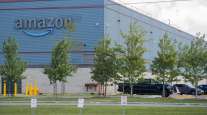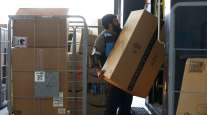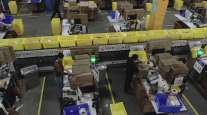Amazon to Close Two Maryland Facilities in October

[Stay on top of transportation news: Get TTNews in your inbox.]
Amazon.com Inc. appears to be scaling back the expansion of what had been its growing delivery network as consumers shift spending habits from the large volume of COVID-19 purchases to a more traditional balance of goods and services.
It is closing two Maryland facilities, one in Baltimore County and the other in nearby Anne Arundel County, on Oct. 25.
The retail giant notified Maryland Department of Labor officials that 353 employees would be impacted by the decision but that they will be offered other positions within the company nearby. Amazon used those facilities to load delivery vans.

Olsavsky
Amazon’s real estate network exploded during the pandemic because of a surge in demand, which Chief Financial Officer Brian Olsavsky said in April has now left it with a surplus of space.
Olsavsky said Amazon doubled the size of its operations and workforce from mid-2021 to April 2022.
According to MWPVL International, a consulting firm that tracks Amazon’s real estate transactions, the company’s cutbacks are much larger than just the Maryland closures. The company has either canceled or delayed plans to open 42 facilities, totaling an estimated 25 million square feet of usable space. Additionally, Amazon is delaying the opening of 21 planned locations.
“Demand is falling away and consumer expenditures are beginning to slow,” said Paul Bingham, director of transportation consulting at S&P Global Market Intelligence. “That continuing, unrelenting demand growth that we saw from the summer of 2020 through early this year has stopped and it’s not quite in reverse, but the volumes are going to fall further.”
Demand is falling away and consumer expenditures are beginning to slow.
Paul Bingham, director of transportation consulting at S&P Global Market Intelligence

Amazon also canceled a handful of European projects, mostly in Spain, the firm said.
While Amazon did not specifically confirm or deny the changes in its Baltimore-area facilities, it did say it is always evaluating its real estate and warehouse portfolio.
“Amazon is a dynamic business, and we are constantly exploring new locations. We weigh a variety of factors when deciding where to develop future sites to best serve customers,” spokeswoman Maria Boschetti said in an email statement. “We have dozens of fulfillment centers, sortation centers and delivery stations under construction and evolving around the world. It’s common for us to explore multiple locations simultaneously and adjust timetables based on needs across the network.”
Amazon had earlier announced it was pausing the opening of its 700,000-square-foot facility in Nebraska until at least 2024.
We have dozens of fulfillment centers, sortation centers and delivery stations under construction and evolving around the world.
Amazon spokeswoman Maria Boschetti
Bingham said the economy is returning to a pre-pandemic balance between goods and services.
“As a society, we’re spending on services. This was a peak year in many years for leisure travel,” Bingham said. “People are now not sitting at home ordering on Amazon all day or buying Peloton fitness systems, and this is likely to continue as they believe the pandemic is not a threat to them and it translates to softer demand for imported goods.”
Amazon acquired the 154,000-square-foot Hanover, Md., facility in 2020 for $90 million. The company did not own the Essex, Md., warehouse.

In this special edition of RoadSigns, hosts Seth Clevenger and Mike Freeze provide an inside look at Transport Topics’ 2022 Top 100 Private Carriers list. Tune in above or by going to RoadSigns.ttnews.com.
“Amazon is a leading indicator when it comes to e-commerce and this is a clear signal they overshot their target,” Bingham said. “Not only do they have too much capacity, but they are also trying to market some of this space to third-party retailers and handle them through their fulfillment network.”
Bingham said as homebound shoppers rushed to buy billions of dollars worth of goods online, Amazon doubled the size of its logistics network during a two-year period. The rapid growth exceeded that of Walmart Inc., UPS Inc. and FedEx Corp.
During the height of the pandemic, Amazon was opening a new warehouse or fulfillment center in the U.S. about every 24 hours.
A 2021 report by Chaddick Institute for Metropolitan Development at DePaul University in Chicago showed Amazon Air, the company’s air carrier, increased its schedule by 15% during the height of the pandemic.
Want more news? Listen to today's daily briefing above or go here for more info
Airports slated to see a larger number of flights included Cincinnati-Northern Kentucky International Airport, Ontario International Airport east of Los Angeles, Rockford International Airport northwest of Chicago, and Fort Worth’s Alliance Airport.
The report said more flights at those airports along with expansion at 27 other domestic airports would allow Amazon to cover all of the United States. The Cincinnati-Northern Kentucky airport is especially critical since cargo can be hauled from there by truck in fewer than 10 hours to portions of the East Coast, Mid-Atlantic, South and Midwest.
Amazon ranks No. 19 on the Transport Topics Top 100 list of the largest private carriers in North America.
UPS ranks No. 1 on the Transport Topics Top 100 list for the largest for-hire carriers in North America and FedEx is No. 2.




